4. El Toro
Image: Jeremy Thompson, Flickr
Location: Six Flags Great Adventure (Jackson, New Jersey)
Opened: 2006
“What makes a roller coaster wooden?” At least for most of thrill ride history, that dichotomy has been rather straightforward… Wooden roller coasters are very different from their steel counterparts. Sure, they’re made of wood. But they’re also associated with a very particular experience: bumping, shuffling, rumbling, roaring, rough, and wild.
The “signature” of a wooden roller coaster is – in many ways – its chaos, created inherently by the way it’s built: with wood that’s sawed, cut, hammered, and bolted on-site. The roughness of wooden roller coasters is built-in by way of the imperfections that arise in this process as well as the way wood naturally ages and wears. Whether you love or hate the sensation, when you’re on a wooden roller coaster, you know it… Right?
Image: Joel A. Rogers, CoasterGallery.com
Swiss manufacturer Intamin – risk-taking creators of ground- and record-breaking rides like Millennium Force, Top Thrill Dragster, and Maverick – came up with an alternative. El Toro is the third roller coaster made of their pre-fabricated track (sometimes called a “Plug and Play” model). Highly engineered, the supports and track for these coasters are literally laser-cut in a laboratory and shipped to the site with assembly instructions (“Insert slot A on piece 881 into slot A on piece 882 and tighten with bolt 9F”), piecing together almost like LEGO blocks.
The precision of this process minimizes the inherent errors in other wooden roller coasters, creating a beautiful, powerful, and smooth wooden roller coaster that begins with a high-speed elevator cable lift, tackles a 181 foot, 75° drop like it’s nothing, sails over out-and-back airtime hills like butter, then races into a twisting, banking, wild finale. So while you’re definitely on a wooden roller coaster, you might not guess it with your eyes closed.
5. The Voyage
Image: Holiday World
Location: Holiday World (Santa Claus, Indiana)
Opened: 2006
Predating Disneyland and opening in 1946 as Santa Claus Land, Indiana's premier theme park (known for its free parking, free sunscreen, and free soft drinks) has since expanded to include holidays well beyond its Christmastime origins. Along the way, the famous family park has evolved into a Mecca for wooden coaster fans. First came 1995's Raven, a harrowing 85 foot coaster in the park's Halloween area. It was joined by the 99 foot tall Legend in 2000.
Image: Holiday World
For many coaster fans, though, Holiday World's magnum opus opened in 2006 in the park's Thanksgiving section. The Voyage is a 160 foot tall coaster whose pricetag topped $8 million. And while – at first glance – it may look like your standard out-and-back wooden coaster, the airtime machine quickly morphs into something else.
It races out into the park's remote woods, twisting and turning and darting through hidden tunnels. Just when you think it must be over, The Voyage has more up its sleeves. The ride is seemingly endless, measuring in at 6,442 feet (well over a mile) with an almost-inconcievable 24.3 cumulative seconds of weightlessness. Fans especially gush over its legendary underground triple-down, when the coaster races down a series of quick drops, flipping stomaches and earning screams.
6. Outlaw Run
Image: Silver Dollar City
Location: Silver Dollar City (Branson, Missouri)
Opened: 2013
Though Intamin may have played with the conventions of wooden coasters with their Plug and Play track, newcomers Rocky Mountain Construction (RMC) re-wrote the rulebook a decade later. In 2011, RMC overhauled the infamously rough Texas Giant at Six Flags Over Texas, tearing out the aging giant’s wooden track and using the leftover structure beneath to install new “IBox” steel track.
The reborn New Texas Giant was smooth, wild, twisted, unpredictable… and steel. In 2013, Six Flags ordered the same IBox treatment for Six Flags Fiesta Texas’ Rattler, creating the equally extreme Iron Rattler – also steel. RMC’s IBox overhauls became a way for parks to turn their aging wooden giants from the ‘70s and ‘80s into anchoring attractions once more via a steel conversion (with 8 such rebuilds to date).
Image: Joel A. Rogers, CoasterGallery.com
But in 2013, they also debuted Outlaw Run, their first from-scratch creation (above). Unlike the IBox steel track, Outlaw Run uses what RMC called “Topper Track.”
While all wooden roller coasters have a thin metal running strip for the train’s wheels, Topper Track replaces the top two layers of wood entirely with a steel “box” set atop six layers of laminated wood. Naturally, that caused enthusiasts to wonder, how thick can that top layer be before a wooden coaster becomes a steel coaster?
In the years since, the consensus has more or less been reached that Outlaw Run – and other Topper Track RMC coasters – do count as wooden roller coasters, even if by nature of their composition, they can do what no other wooden coasters can. And with that in mind, Outlaw Run’s three inversions (a 153° overbanked turn and a double heartline roll) would make it the first wooden roller coaster after Son of Beast to turn riders upside down… albeit, much more gracefully.
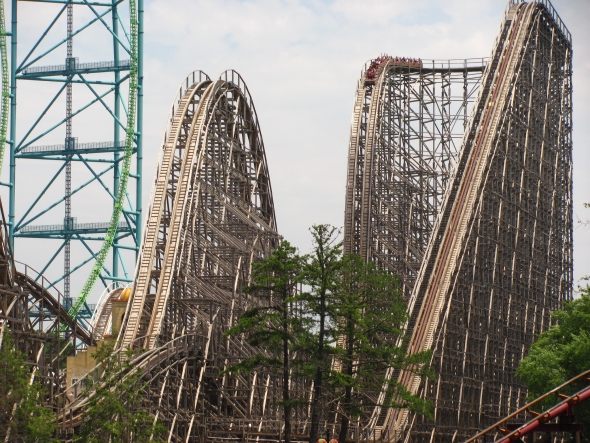
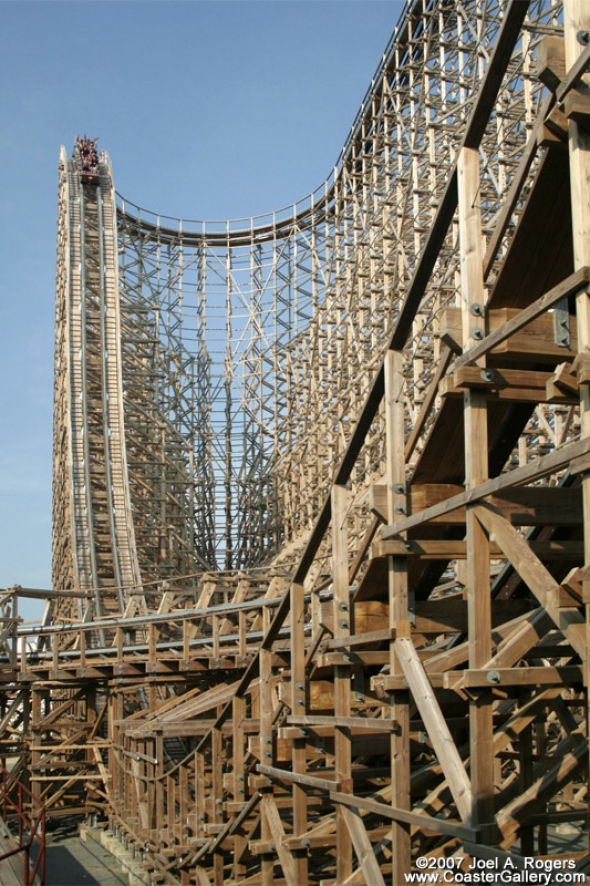
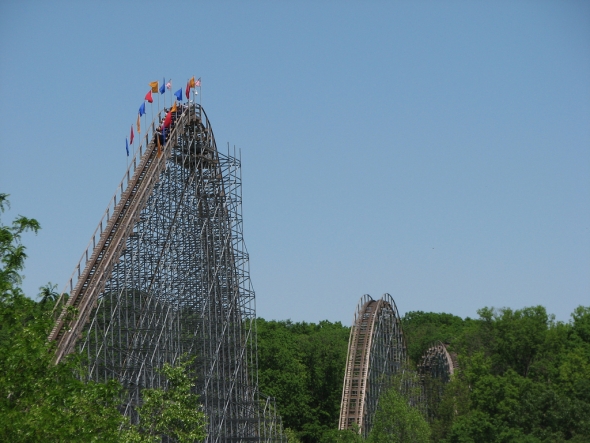
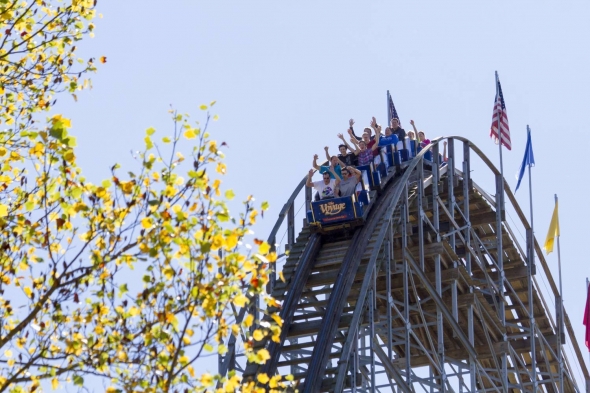
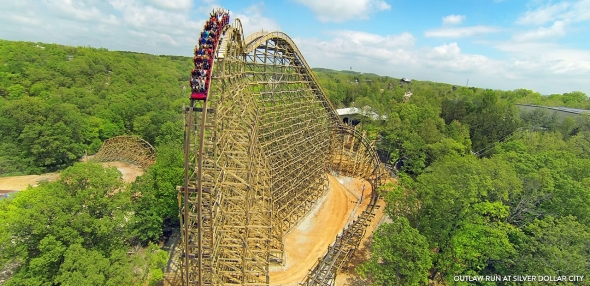
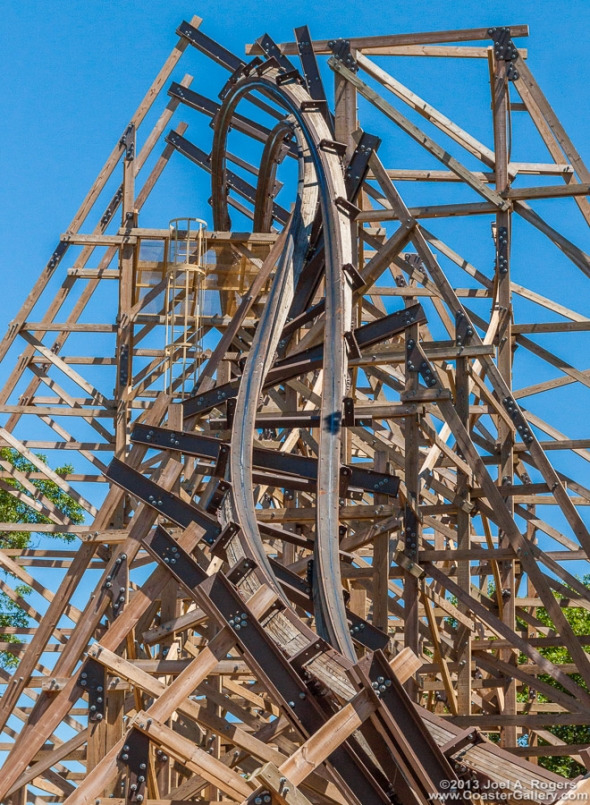

Add new comment